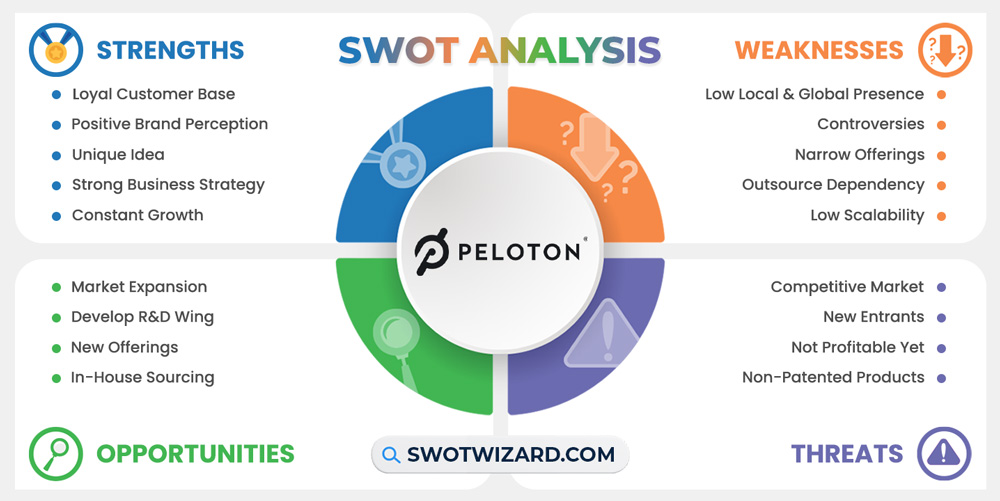It’s almost impossible to never hear about the company “Peloton” if you’re even slightly concerned about fitness. The company has disrupted several markets with its offerings, including cycling, streaming, and other fitness services.
It was possible because of its loyal customer base, disruptive and unique idea, and robust business strategy. But, in recent years, after covid, there has been a declining phase in revenue and profit. We will get to know about its internal and external factors in this Peloton SWOT analysis.
Peloton: Company Overview
| Company | Peloton Interactive, Inc. |
| Industry | Exercise equipment |
| Founded | 3 January, 2012 |
| Founder | Graham Stanton, Hisao Kushi, John Foley, Tom Cortese, Yony Feng |
| CEO | Barry McCarthy |
| Headquarter | New York City, United States |
| No. of Employees | 8,662+ |
| Annual Revenue | $4.02 billion (FY 2021) |
| Website | onepeloton.com |
With the idea of combining house fitness tech and hardware, the company was founded in 2012 by John Foley. After that, with the rise of online streaming, they introduced fitness classes, where people can pay a monthly subscription fee and be their mentors. That’s where they got the name “Netflix for fitness.”
With 123 showrooms, more than three million subscribers, and 8,662 employees, the company has grown bigger than ever. And, with the $1.826 B of revenue, they are still trying to become profitable in a few years. They got the unicorn tag back in 2017.
The customer base is growing, and the recurring subscription rate is impressive too. But, there are some new issues the company faces in this new era, which we will discuss in the later sections.
Product & Services of Peloton
Stationary Exercise Bikes | Treadmills | App for Online Fitness Classes
Peloton Competitors
Life Fitness | SoulCycle | Nordic Track | Flywheel Sports | Echelon | BowFlex | Mirror | Equinox Fitness
Did You Know?
Peloton has one of the most extensive audio libraries with a global license. The library has more than 2 Million audio and songs, and the number is growing daily.
Strengths – Peloton SWOT Analysis

Loyal Customer Base: A loyal customer base is one of the greatest strengths a company could ask for. And, In 2022, Peloton has around three million loyal base, and most of the customers are recurring subscribers. It shows in the data as about 90% of them were retention customers in 2022.
Positive Brand Perception: Being the first mover in the industry awith a unique idea comes with its advantage. And from its inception, the company has been very successful at maintaining positive brand value and has been recognized for its presence in many countries with a solid customer base.
Unique Idea: Finding the exact need of the customers and fulfilling them can be very rewarding, and Peloton does precisely that. When the company launched, it came up with a unique idea to combine hardware and software to give customers everything in one package. As a result, the recurring subscription rate is very high.
Strong Business Strategy: With its unique market offerings, they have a solid business plan. Their revenue model is diversified with different categories. As a result, in the fiscal year of 2022, their total revenue was $3.58 B, and the sales ratio between equipment and subscription was 45:55, which is the industry standard.
Constant Growth: Peloton has successfully grown the business in every aspect. Even after increasing the subscription fee in 2022 by $5-$6, the customer base is still growing, and so is the revenue. With their exceptional service, they were able to grow the business and the stock price.
Weaknesses – Peloton SWOT Analysis

Low Local & Global Presence: Even though Peloton is a very famous brand with an online presence, its overall offline local and global presence is meager. The company has only 94 stores in the USA, and a few other stores in countries like the UK, Canada, and Germany is not even close to enough.
Controversies: There have been several controversies against Peloton in the last five years. In 2019, they made an advertisement on one of their products labeled as a ‘dystopian, sexist’ advertisement and lost more than $1.5 B in value just because of it.
Narrow Offerings: Their online products and services are great, and there is no question. But, their hardware product line is very narrow, and customers don’t have many choices as they have only bicycles and treadmills, only with two variations which are really low.
Outsource Dependency: One of their greatest weakness is most of their content, services, and products are outsourced by third parties. As a result, they don’t have complete authority over the quality and overall operations. That makes them vulnerable in the long term.
Low Scalability: Market saturation is a part of the process, and the signs are clearly showing for Peloton. Most of their target markets are in advanced countries, and they reached the highest growth point in these countries and economies of scale. As a result, without expanding the market, they will be out of the market because of low scalability.
Opportunities – Peloton SWOT Analysis

Market Expansion: With their loyal customer base, consistent growth, and unique offerings, they have the perfect opportunity to expand to new markets. With market saturation coming in the upcoming days, now is the time to move into developed, developing countries to make a firm hold.
Develop R&D Wing: One significant reason for companies is to bring more innovative products and services into the market. But, Peloton’s reason behind having a narrow offering is their low funding in the R&D wing. For this reason, the CEO even said they should look into this matter and develop a more effective R&D branch.
New Offerings: Without new products and services in the market, it’s difficult to survive in the long term. As a result, with an advanced R&D team behind them, they should bring new products, specifically in the hardware section, to the existing market. That way, they can at least slow down the market saturation process.
In-House Sourcing: Heavily depending on third parties is not feasible and inefficient. Even though it simplifies the process, Peloton even moved entirely into depending on third parties for deliveries in a few areas. But, having its delivery system and manufacturing facilities could be cost-effective and have absolute control over the quality and operational process.
Threats – Peloton SWOT Analysis

Competitive Market: Peloton not only competes with various online services but also in hardware, such as treadmills and bicycle pieces of equipment. As there are already enough competitors with lower and better offerings, this poses a direct threat to the company.
New Entrants: The market barrier for this industry is very low. As Peloton was the first mover, they researched and developed the perfect business model, and so were the other competitors. As a result, anyone with enough capital can jump into the industry, outsource everything and start the exact same business strategy.
Not Profitable Yet: Even with a huge subscriber base, quality products and services, and considerable revenue, the company isn’t profitable. As a matter of fact, they are drowning in losses. With declining profits, it will be very difficult to expand and build an R&D wing for further expansion.
Non-Patented Products: There are several issues regarding the non-patented products of Peloton. Even the company had to pay $19M for a penalty lawsuit related to this issue. Besides, competitors and new entrants are directly copying the company’s products, and they can do nothing because of their non-patented products.
[Bonus Infographic] SWOT Analysis of Peloton

Recommendations for Peloton
Peloton has been on the rise in the last decade with its innovative products and services. As a result, they have become a large company to date. But, as time goes on, they are facing new issues daily. Here are some recommendations for them to overcome those difficulties;
- The priority should be expanding the market. As the advanced country markets are saturated with the products, they should focus on creating markets in developed and developing countries.
- The research and development wing should be well-funded and bring innovative products into the market. As the company doesn’t have enough products to offer, they need to start working on this.
- Relying on third parties should be less and less in the upcoming years, and it can become an issue regarding quality.
- They should start working on scalability in the existing markets. It can result in more revenue, thus creating an opportunity for more profits.
Frequently Asked Questions (FAQs)
Can I Ride Peloton for Free?
Yes, a free ride mode is available in Peloton if you don’t want to pay the subscription fee.
Can You Watch TV on Peloton?
Yes, you can watch TV on Peloton.
Final Words on Peloton SWOT Analysis
In 11 years of the history of Peloton, it has come a long way. With its growing popularity and revenue, even with narrow product and service offerings, it’s going great. But, there are some patent-related issues and controversies, and the market is already competitive. Besides, with its low-funded R&D wing, it will be difficult in the upcoming days. So, to stay relevant and survive in the market, they need to focus on expanding, bringing new market offerings, and relying more on in-house sourcing to become cost-effective.
References
- Wikipedia contributors. (n.d.). Peloton Interactive. Wikipedia.
- Gough, C. (2022b, September 27). Number of Peloton subscriptions worldwide from 2018 to 2022. Statista.
- Gough, C. (2022a, September 27). Annual connected fitness product revenue of Peloton worldwide from 2017 to 2022. Statista.
- Malik, A. (2022, April 15). Peloton is increasing its subscription fees starting June 1. TechCrunch.
- Number of Peloton stores in the United States in 2023. (2023, January 20). ScrapeHero.
- Belam, M., & Partridge, J. (2019, December 4). Peloton loses $1.5bn in value over “dystopian, sexist” exercise bike ad. The Guardian.
- Thomas, L. (2022, July 12). Peloton to outsource all manufacturing as part of its turnaround efforts. CNBC.
- Lewis, C. (2021, March 23). Peloton CEO John Foley talks innovation + R&D and is asked about Peloton Strength Hardware & Peloton Rower. Peloton Buddy.
- Weicher, K. (2023, January 5). Peloton to Pay $19 Million Civil Penalty to the Consumer Product Safety Commission (CPSC) related to Tread+ Recall. Peloton Buddy.




